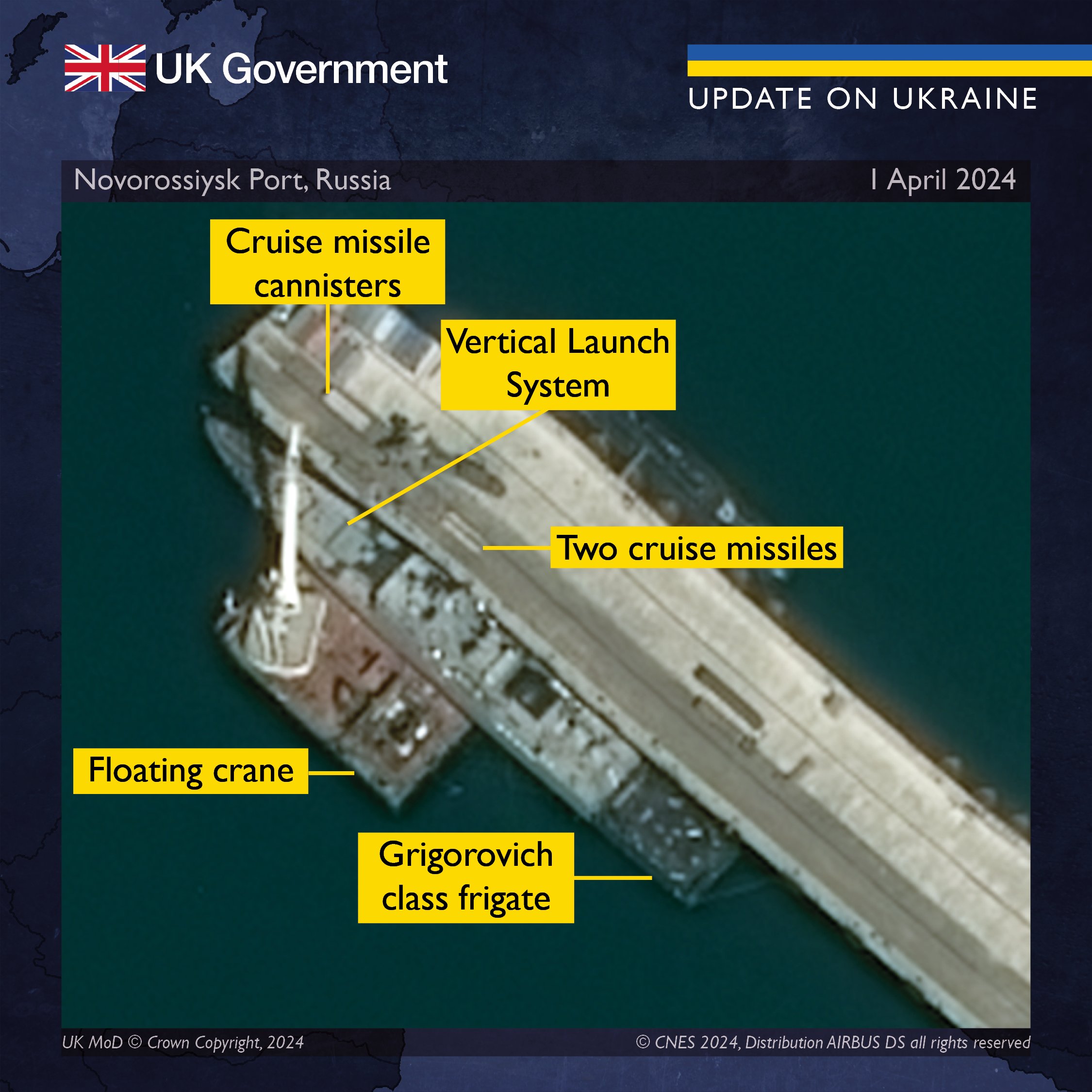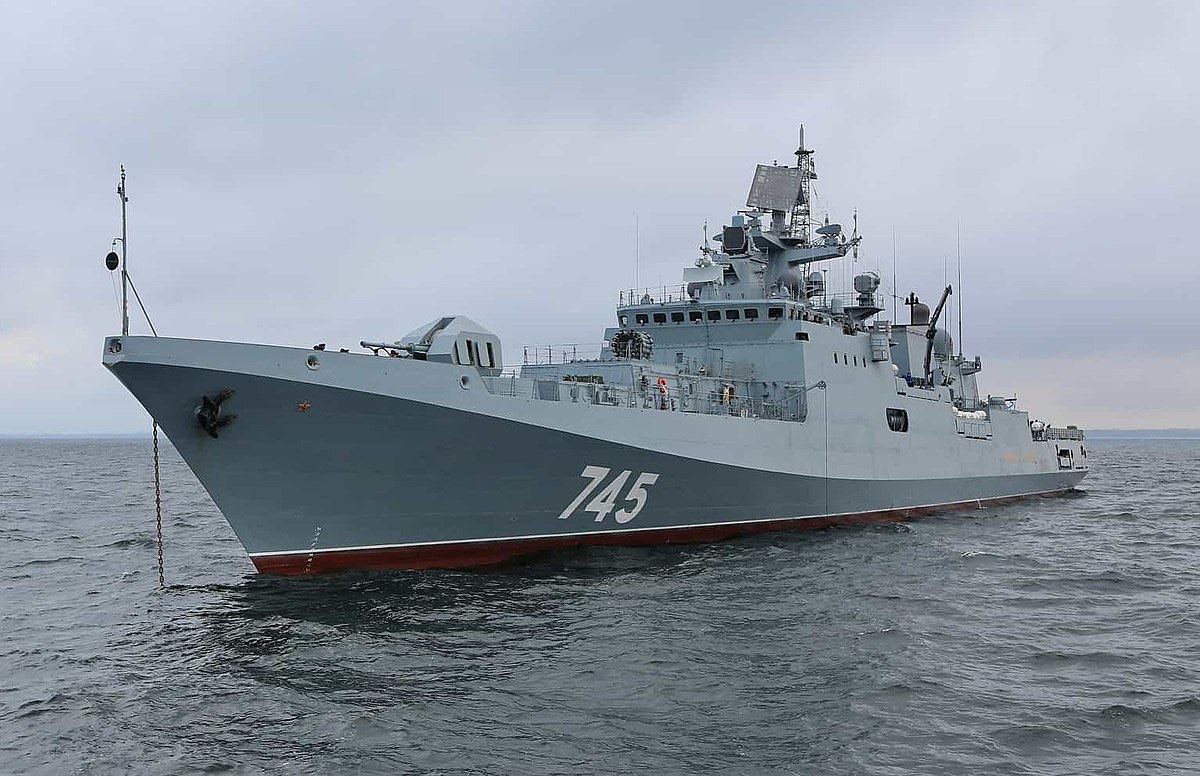A large Russian frigate, Admiral Grigorovich, was seen docked and reloading weapons and possibly other supplies at the Novorossiysk Naval Base in far western Russia on the Black Sea.
This comes after Russia moved nearly all its major warships and naval assets to Novorossiysk from Sevastopol in Crimea in October 2023, after a series of naval kamikaze drone boat and missile attacks by Ukraine.
While the naval war has continued, the appearance of a large warship means that Russia’s Black Sea Fleet (BSF) remains intact and could intensify its sea-launched cruise missile strikes into Ukraine. The strikes could take place from the safety of the BSF’s home port in sovereign Russian territory.
Ukraine and the West accused Russia of illegally annexing Crimea in 2014, while Moscow maintains the region voted to be a part of the Russian Federation in a democratically-held referendum.
Interestingly, the Admiral Grigorovich-class frigates are the same as the Indian Navy’s (IN) Talwar-class warships, six of which are operating as frontline combat vessels in the IN’s Western Fleet. Also identified as the Krivak V-class vessels, they are improved versions of the Krivak III boats used by the Russian Coast Guard.
Six ships were built for the Indian Navy between 1999 and 2013 at shipyards like the Yantar Shipyard in Kaliningrad. They were split into two classes of three warships each: the INS Talwar-class and the INS Teg-class.
‘Novorossiysk is Best for the Black Sea Fleet’
According to an intelligence update by the British Ministry of Defense (MoD), a satellite photo earlier this month showed a Grigorovich-class guided missile frigate undertaking “weapons handling activity at the Black Sea Fleet (BSF) facility, Novorossiysk port.”
The update added that modern Russian warships like the Grigorovich have “vertical launch systems for firing cruise missiles at sea and land targets” and that such missiles have “historically been reloaded in Sevastopol, Crimea.”
The observation hints that the UK was expecting the platform to be used to send its 3M54-1 Kalibr cruise missiles or the BrahMos’s predecessor, the P-800 Oniks (Onyx), in the periodical sea and air-launched standoff long-range fires Russia conducts deep into Ukraine.

Russian bombers like the Tu-160 fire the Kh-101 (X-101) while Russian ground troops fire the Iskander tactical ballistic missile and the Geran-2 kamikaze drones.
Smaller BSF missile boats and the Bastion-P coastal defense batteries fire the Kalibr and the Oniks, respectively. Rossiskaya Gazeta also claimed that the Zircon hypersonic anti-ship missile could be launched from the 3S14 universal launchers that are used to fire the Kalibr and Oniks missiles, making the Grigorovich capable of operating it.
The UK MoD said the BSF has “largely withdrawn its ships and submarines from Sevastopol further eastwards to Novorossiysk (and) has been least active since the war began (especially after) the removal of the BSF commander in March 2024.”
At Novorossiysk, the BSF “(is) best (protected from) Ukrainian sea-borne attack” while “its maintenance, logistics and weapons handling infrastructure has highly likely been improved at the new basing arrangement.”
Russian Calculations In The Black Sea War
The frigate’s appearance in the Black Sea comes at a time when Ukraine and the US are trying to leverage success on that water body to impact land operations. This largely attests to prior EurAsian Times analysis about Ukrainian calculations and Washington’s vision of reversing Russia’s strategic gains in the war.
Eight months after the war began in February 2022, the BSF in Sevastopol first came under constant unsuccessful attacks. But September 22, 2023, saw Ukrainian aerial strikes using British-French Storm Shadow cruise missiles that brought down the entire BSF Headquarters building. This forced Russian planners to relocate the BSF HQ to Novorossiysk.
This was Russia’s strategy to bait Ukrainians into continuing the strikes. Novorossiysk, unlike Crimea, is an internationally and NATO-recognized Russian sovereign territory. Attacking it would legitimize Moscow bombing NATO territory in Poland or Romania, from where the Ukrainian military receives technical and logistical support, or shooting down the E-3C AWACS, RC-135 Rivet EW aircraft, or the MQ-4 Global Hawk drone. The last three aircraft help Ukraine identify Russian radar positions and supply targeting data.

The BSF already has a series of small and medium-sized missile boats and large radar-guided patrol boats that undertake sea-borne tasks or destroy Ukrainian USVs. This is beside Russian naval aviation, which includes MiG-29 fighters and SU-30SM jets that have strafed small commando-carrying motorboats in recent incidents. Even Kamov Ka-27 helicopters are used to detect and attack the boats.
Late last year, the BSF lost several small and medium-sized vessels and a submarine after the Ukrainians introduced a series of new kamikaze drone boats like the Magura V5 and the Sea Baby, attacking in unpredictable patterns and timings. However, the BSF’s overall strength remains largely intact, and all its capital ships—except the loss of the Moskva in 2022—are safe in the harbor. Based at Novorossiysk, they are even further outside the range of Ukrainian sea drones.
India’s INS Talwar
The Indian Navy’s Talwars and Teg class boats are useful in “finding and eliminating enemy submarines and large surface ships.” The lead warship, INS Talwar, was commissioned on June 18, 2003, with the Trishul and Tabar inducted on June 25, 2003, and April 19, 2004. The Teg-class consists of the INS Teg (April 27, 2012), INS Tarkash (November 12, 2012), and INS Trikand (June 29, 2013).
Only recently, the INS Talwar found itself in the news after it seized 940 kg of drugs in the Arabian Sea on April 13, becoming the Indian Navy’s first interdiction of illicit narcotics as a member of the Combined Maritime Forces (CMF), a 42-nation naval partnership.
The warship, operating in support of the Canadian-led Combined Task Force (CTF) 150, seized 453 kg of methamphetamines, 416 kg of hash, and 71 kg of heroin from a dhow as part of Focused Operation Crimson Barracuda, it said.
- The author can be reached at satamp@gmail.com
- Follow EurAsian Times on Google News




